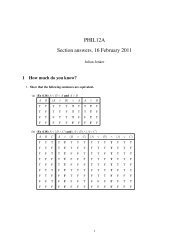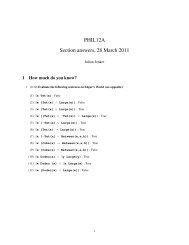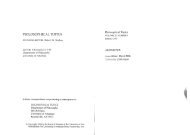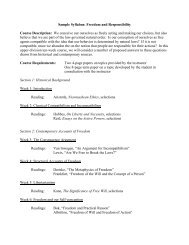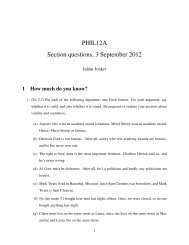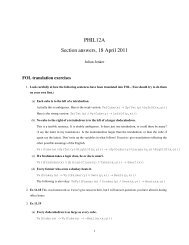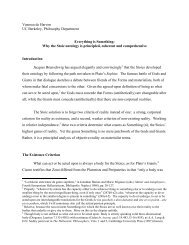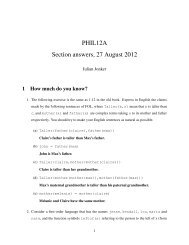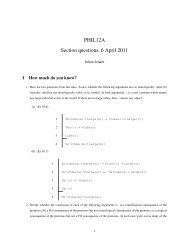Rational Self-Doubt - Philosophy
Rational Self-Doubt - Philosophy
Rational Self-Doubt - Philosophy
- No tags were found...
You also want an ePaper? Increase the reach of your titles
YUMPU automatically turns print PDFs into web optimized ePapers that Google loves.
<strong>Rational</strong> <strong>Self</strong>-<strong>Doubt</strong>Sherri RoushDepartment of <strong>Philosophy</strong>Logic GroupU.C., Berkeleyroush@berkeley.edu1
This work was funded by NSF grant SES -0823418:“Fallibility and Revisionin Science and Society”2
Judgmental <strong>Self</strong>-<strong>Doubt</strong>Second-guessing your opinion on the basis of evidence aboutyour cognitive skills or circumstances. Example occasions:-- You are confident in your memory of certain events, and thenfind out you are on mind-altering drugs.-- You are confident that the murderer is number 3 in the lineup,and then find out that human beings are generallyunreliable in eyewitness testimony.-- You are watching for a tiger and your visual field suddenly goesblank.-- You are a woman not fully confident of your argument, andthen discover that women are generally underconfident.4
More problematically …The evolutionist admits to the Creationist that our theories might bewrong. The latter concludes his view is just as good. Every view isjust a hypothesis! 60% of Americans appear to agree.You admit that most past scientific theories have been false, and areexpected to withdraw confidence in yours. (Pessimistic inductionover the history of science.)You are contemplating marriage and read that the divorce rate is 60%.5
Evidence about q vs. evidence aboutyourself wrt qYou are confident that the murderer is #3 in the line-up,and then remember that the murderer was missinghis left pinky finger. #3 is not.vs.You are confident that the murderer is #3 in the line-up,and then find out that human beings are generallyunreliable in eyewitness testimony.Evidence about the murderer vs. evidence about yourself6
Evidence about q vs. evidence aboutq … There is no tiger aroundyourselfYou are confident of q, and then see an orange, furryrustling in the trees.vs.You are confident of q, and then your visual field goesentirely blank.In second case, you gain no evidence about tigers, yetintuitively you should change your confidence in q.If so, then this revision cannot be modeled at the first order.7
Terms – 1 st - and 2 nd - order evidenceThere are different orders of evidence. So:1 st -order evidence about q, It will rain, is:The barometer reads low pressure.2 nd -order evidence is about your beliefs and theirproperties:The owner of the house says the barometer has beenrusted stuck for five years.Conditionalization: assimilating new evidence byprobabilistically “updating” all of your other beliefs.8
Terms – 1 st – and 2 nd - order beliefAnything that is evidence or hypothesis for you is one of your beliefs:Let q be any proposition not containing a belief predicate, e.g.:The murderer used a knife.You have a first-order belief in q when you believe q. You express this:“The murderer used a knife.”You have a second-order belief (belief about a belief) when you believethat you believe q. To express this belief you say:“I believe that the murderer used a knife”If I describe you, I use one belief predicate vs. two belief predicatesI say: “He believes q” vs. “He believes that he believes q”9
What is the rational thing to do?1) Assimilate 2 nd -order evidence:-- Surely you have to do something.-- Otherwise you violate the Principle of Total Evidence.2) Ignore 2 nd -order evidence:-- If you start second-guessing, how do you stop? Arbitrarily?-- 2 nd -order probabilities don’t exist, are trivial, are incoherent.-- Miller’s Principle (a.k.a. <strong>Self</strong>-Respect)-- 2 nd order revision could be distorting-- Is there any added value?10
Degrees of belief as probabilitiesq, r, s, …, q’, r’, s’, …, P S (q) = x, P S (r) = y, … propositionsP S (q) = x … Subject S has degree of belief x in qP S (q/r) = z … S’s degree of belief in q given r is zP T (P S (q) = x) = x’ … Subject T has degree of belief x’ thatsubject S has degree of belief x in q.P S (P S (q) = x) = x’’ … Subject S has degree of belief x’’ thatsubject S has degree of belief x in q.11
Second-Order ProbabilitiesA second-order probability is a degree of belief about a degree of belief.Don’t exist: A belief is an expression. People can’t have opinions about them.A degree of belief is a disposition to act that has a certain strength. (FrankRamsey) It can be measured by betting behavior. Same for beliefs aboutwhat your beliefs are: we ask you to bet about how you would bet.Are trivial: All of them will be 0 or 1.Being rationally fully confident and accurate requires an infallibility wedon’t have.Better: Bayesian rationality (probabilistic coherence) shouldn’t haverequirements on substantive knowledge.Skyrms, Brian. 1980. “Higher-Order Degrees of Belief.” In D. H. Mellor (ed.),Prospects for Pragmatism: Essays in Memory of F. P. Ramsey.12
Agenda – Generalizing Bayesian<strong>Rational</strong>ityRule for 2 nd -order revisionDefenseApplicationsMore defense13
The Principle that Gets in the WayP(q/P(q) = x) = x<strong>Self</strong>-Respect (SR)What you think your degree of belief in q is iswhat your degree of belief should be.Don’t disapprove of your own degrees of belief.(Traditionally called “Miller’s Principle.”)14
Restricted <strong>Self</strong>-Respect (RSR)P(q/P(q) = x) = xprovided there is no statement of probabilitywhich when combined with “P(q) = x” isrelevant to q.This says: The mere fact that you have a degree ofbelief is not a reason to have a different degree ofbelief.15
Restricted <strong>Self</strong>-Respect (RSR)P(q/P(q) = x) = xprovided there is no statement of probabilitywhich when combined with “P(q) = x” isrelevant to q.This says: The mere fact that you have a degree of beliefis not a reason to have a different degree of belief.16
Unrestricted <strong>Self</strong>-Respect (USR)P(q/P(q) = x . r) = xfor any statement of probability rfor which P has a valueI.e., no matter what else the subject believes.17
Unrestricted <strong>Self</strong>-Respect (USR)P(q/P(q) = x . r) = xfor any statement of probability rfor which P has a valueI.e., no matter what else the subject believes.We need to generalize away from this, preserving RSR.18
Expressing ReliabilityS is reliable to degree y when believing q todegree x iffPR(q/P(q) = x) = y(same as fallible to degree 1-y)“PR” means objective probability, whatever kindyou like.19
Expressing the QuandaryExplicitly:P(q/P(q) = x . PR(q/P(q) = x) = y) = ?20
Expressing the QuandaryExplicitly:P(q/ ) = ?Incoming evidence:P(q) = x . PR(q/P(q) = x) = y21
Expressing the QuandaryExplicitly:P(q/P(q) = x . PR(q/P(q) = x) = y) = ?USR says r doesn’t matter:P(q/P(q) = x . PR(q/P(q) = x) = y) = x22
Expressing the QuandaryLiterally:P(q/P(q) = x . PR(q/P(q) = x) = y) = ?USR: P(q/P(q) = x . PR(q/P(q) = x) = y) = xBut consider:P(q/P(q) = x . PR(q/P(q) = x) = y) = ?=* P(q/PR(q) = y) = ?23
Principal PrincipleP(q/PR(q) = y . s) = yI.e., Your degrees of belief should conform towhat you think the objective probability is.(provided s is admissible, etc., but no need for shere.)24
Forced ChoiceP(q/P(q) = x . PR(q/P(q) = x) = y) = ?USR:P(q/P(q) = x . PR(q/P(q) = x) = y) = xPrincipal Principle:P(q/P(q) = x . PR(q/P(q) = x) = y) =* y25
What’s good for the goose is good forthe gander.Our respect for the judgment of others is notunconditional:P T (q/P S (q) = x . PR(q/P S (q) = x) = y) = yP T (q/P T (q) = x . PR(q/P T (q) = x) = y) = y26
Calibration and Re-calibrationCal(synchronic constraint)P(q/P(q) = x . PR(q/P(q) = x) = y) = yRe-Cal(diachronic constraint)P f (q) = P i (q/P i (q) = x . PR(q/P i (q) = x) = y) = yTo be calibrated is for one’s confidence to match one’sbelieved reliability. (x = y)To re-calibrate is to update one’s confidence in light ofinformation about one’s reliability. (x y)27
Calibration and Re-calibrationCal(synchronic constraint)P(q/P(q) = x . PR(q/P(q) = x) = y) = yRe-Cal(diachronic constraint)P f (q) = P i (q/P i (q) = x . PR(q/P i (q) = x) = y) = yDefended in:Roush, “Second-Guessing: A <strong>Self</strong>-Help Manual,” Episteme 6.3(2009): 251-268.Roush, “The Re-Calibrating Bayesian,” manuscript28
ApplicationsEyewitness caseTiger caseCreationist casePessimistic InductionRoush, “Optimism about the Pessimistic Induction,”New Waves in <strong>Philosophy</strong> of Science,Palgrave-MacMillan, 2010.29
Taking StockSupposed reasons to ignore 2 nd -order evidence:-- If you start second-guessing, how do you stop?Arbitrarily?-- 2 nd -order probabilities don’t exist, are trivial, areincoherent.-- Miller’s Principle (a.k.a. <strong>Self</strong>-Respect)-- 2 nd order revision could be distorting-- Is there any added value?30
Incoherence charges1) Against Cal and Re-Cal2) Against applying the function P toP-statements.31
Incoherence of Cal?1. P(q) = x,2. P(P(q) = x) = 1, and3. P(PR(q/P(q) = x) = y) = 14. x ≠ yCal says:P[q/(P(q) = x . PR(q/P(q) = x) = y)] = yFrom 2. , 3., Cal, and *, we get P(q) = y.But by assumption 1., P(q) = x. Contradiction.32
Incoherence of Cal? Nah.1. P(q) = x,2. P(P(q) = x) = 1, and3. P(PR(q/P(q) = x) = y) = 14. x ≠ yCal says:P[q/(P(q) = x . PR(q/P(q) = x) = y)] = yFrom 2. , 3., Cal, and *, we get P(q) = y.But by assumption 1., P(q) = x. Contradiction.33
Incoherence of Second-orderPower Set problem:Probability?Assume that the domain of the probability function P is allpropositions of form q, r, etc., and P(q) = x, P(r) = y, and all Booleancombinations thereof.Let S 1 , S 2 , S 3 , … be the subsets of the set of propositions (in the domainof P). For each one, we can construct a distinct proposition (in thedomain of P):P(p) = z if and only if p is a member of S 1 . We’ve just mapped the set of subsets of the propositions into theset of propositions.34
SolutionsTyped theory?Re-CalWon’t do the jobP f (q) = P i (q/P i (q) = x . PR(q/P i (q) = x) = y) = y The class of propositions is not a set.But then probability must be definable on proper classes.It is:Rubin, Herman, A new approach to the foundations of probability.1969 Foundations of Mathematics (Symposium CommemoratingKurt Gödel, Columbus, Ohio, 1966) pp. 46--50 Springer, New York35
Taking StockSupposed reasons to ignore 2 nd -order evidence:-- If you start second-guessing, how do you stop?Arbitrarily?-- 2 nd -order probabilities don’t exist, are trivial, areincoherent.-- Miller’s Principle-- 2 nd order revision could be distorting-- Is there any added value?36
Taking StockSupposed reasons to ignore 2 nd -order evidence:-- If you start second-guessing, how do you stop?Arbitrarily?-- 2 nd -order probabilities don’t exist, are trivial, areincoherent.-- Miller’s Principle-- 2 nd order revision could be distorting-- Is there any added value?37
Regress and PathologyRe-CalP f (q) = P i (q/P i (q) = x . PR(q/P i (q) = x) = y) = yThis yields a new first-order degree of belief inq, so it looks like Re-Cal is applicable again.38
Regress and Pathology - NoRe-CalP f (q) = P i (q/P i (q) = x . PR(q/P i (q) = x) = y) = yThis yields a new first-order degree of belief in q, soRe-Cal is applicable again?1. Yes, provided you have more evidence.2. Yes, that’s how conditionalization works.39
Regress and Pathology - NoRe-CalP f (q) = P i (q/P i (q) = x . PR(q/P i (q) = x) = y) = yThis yields a new first-order degree of belief in q, soRe-Cal is applicable again …1. Yes, provided you have more evidence.2. Yes, that’s how conditionalization works.Be precise, be happy!40
Is Recalibration distorting?Seidenfeld, Teddy, 1985. “Calibration, Coherence, and ScoringRules.” <strong>Philosophy</strong> of Science 52(2): 274-94.Problem: You can be calibrated in your confidence about rain byknowing that 20% of the days in the year it rains in your localeand announcing 20% chance of rain every day.You have no discrimination. You could hedge your bets this way. Calibration is an improper scoring rule.Re-Cal is not a scoring rule, but a principle of conditionalization.41
Distorting in the long run?The (Principal Principle) direct inference embedded in Re-Cal goes likethis, for day j:P[q j / P(q j )=x j . Ch(q v ,P(q v )=x)=y(x) . K] = y(x)You will have the right degree of belief in q if you have the right chance(or objective probability) hypothesis (function), i.e., the correct y(x).So, the issue is whether in the long run we can converge on the correctchance hypothesis (function), e.g., the chance of rain on a given day(q v )on which the subject believes to degree x that it will rain.The outcomes that give us evidence for that are instances of degreesof belief in rain and whether it rained, on all the previous days.42
Likelihood Ratio Convergence Theorem (LRCT)Hawthorne, James, “Inductive Logic,” Stanford Encyclopediaof <strong>Philosophy</strong>.Likelihood Ratio:P(e/h)/P(e/-h)Suppose you will be fed separating evidence, that is h, -h predict atleast some different outcomes in the stream of evidence you’regoing to get. (All the work in application is here.)Then if h is the true hypothesis it is probable that you will seeoutcomes that rule out all the –h hypotheses within a certainnumber of trials. (Law of Large Numbers)43
Likelihood Ratio Convergence Theorem (LRCT)Hawthorne, James, “Inductive Logic,” Stanford Encyclopediaof <strong>Philosophy</strong>.Likelihood Ratio:P(e/h)/P(e/-h)Suppose you will be fed separating evidence, that is h, -h predict atleast some different outcomes in the stream of evidence. Then it isprobable that you will see outcomes that rule out all the -hhypotheses within a certain number of trials.An LRCT theorem can be proven for the chance hypothesis (function)Of Re-Cal, i.e., where h = Ch(q v ,P(q v )=x)=y(x)Adding second-order conditioning to first-order conditioning isnot distorting in the long run.44
Pointless?Seidenfeld: 1 st -order conditionalizationalone gets you to the truth about q (andto calibration) in the long run. Whybother with the re-calibration rule?45
PointSeidenfeld: Why bother with the second order recalibrationrule?-- If you think PP is a short-run rationality constraint,and you are a human being, then you have tofollow Re-Cal.-- Re-Cal can change extreme degrees of belief.-- Conditionalization on 2 nd -order alone will convergeto truth about q.-- Assumptions the subject treats as unfalsifiable atthe first order can be escaped by using Re-Cal.46
Revising extreme probabilitiesP f (q) = P i (q/P i (q) = x . PR(q/P i (q) = x) = y) = yIf q is an empirical proposition, and x is 1, y may notbe 1.(Just because you are certain of q does not meanthe objective probability of q is 1.)47
Re-Cal Re-capNews about reliability level could require:merely a moment of silence (if already calibrated)loss of confidenceuptick in confidenceThe effect depends on quantity, and is not runaway.A rational subject retains unity and coherence not by perfectself-knowledge or unconditional self-respect but bycoherently 1) handling fallibility, and 2) conforming to a singleprobability function at two orders.Re-Cal 1) is required by the Principal Principle, 2) is coherent, 3)is not distorting, 4) converges in the long run, 5) has addedvalue over first-order conditionalization.48
P f (q) = P i (q/P i (q) = x . PR(q/P i (q) = x) = y) = y49
Assume:P(q) = xP(P(q) = x) = 1By definition of conditional probability:P(q/P(q) = x) = P(q . P(q) = x)/ P(P(q) = x)= P(q)(because P(P(q) = x) = 1) P(q/P(q) = x) = x50



